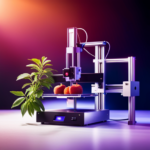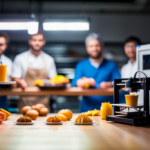Embark on a culinary journey where the realms of augmented reality and 3D printing converge to redefine the gastronomic landscape.
This article delves into the transformative fusion of technology and food design, unveiling the potential for personalized creations and experiential dining.
Explore the innovative advancements in 3D-printed cuisine and the boundless possibilities that AR-driven culinary arts offer.
Join us as we unravel the future of gastronomy through the lens of augmented reality and 3D printing.
The Intersection of AR and Food Design
The intersection of augmented reality (AR) and food design offers innovative opportunities for enhancing the visual presentation and customization of culinary creations. AR visualization in food design allows for the projection of digital information onto real-world culinary creations, enabling chefs to experiment with novel food presentation techniques. This technological integration opens up new avenues for culinary creativity, as chefs can overlay digital designs onto physical dishes, creating visually stunning and immersive dining experiences. By leveraging AR, chefs can also provide diners with a deeper understanding of the ingredients and cooking processes, adding an educational element to the dining experience.
Furthermore, AR can be used to personalize the presentation of dishes based on diners’ preferences, dietary restrictions, or special occasions, thereby enhancing customer satisfaction and overall dining experience. The seamless integration of AR into food design not only elevates the aesthetic appeal of dishes but also allows for greater customization, ultimately revolutionizing the way culinary creations are conceptualized and presented in the modern gastronomic landscape.
As we delve further into the realm of technological advancements in culinary design, personalized culinary creations with 3D printing emerge as a fascinating frontier in the culinary world.
Personalized Culinary Creations With 3D Printing
Augmented reality’s integration with food design has paved the way for personalized culinary creations through 3D printing, offering chefs unprecedented opportunities for precision and customization. With the use of 3D printing technology, chefs can now explore innovative ways to enhance the dining experience, from creating visually stunning dishes to crafting unique flavor profiles. This advancement in food design allows for personalized plating techniques and opens up a world of possibilities for culinary artists to express their creativity in unprecedented ways.
Chefs can now delight their diners with intricately designed 3D printed flavor bursts, adding an element of surprise and delight to each bite. The ability to customize plating techniques through 3D printing enables chefs to elevate the sensory experience, evoking nostalgia or creating a sense of wonder through visually captivating presentations.
These advancements not only elevate the artistry of culinary creations but also have the power to evoke emotional connections, leaving a lasting impression on diners and enhancing their overall dining experience.
Enhancing Dining Experiences Through AR
In the realm of dining experiences, augmented reality (AR) offers a range of possibilities to elevate the interaction between diners and their meals.
Virtual menu customization allows patrons to visualize and tailor their dishes before ordering, while interactive table settings create an engaging and dynamic environment.
Additionally, AR can bring culinary storytelling to life, immersing diners in the history and context of the dishes they are enjoying.
Virtual Menu Customization
Enhancing dining experiences through AR involves customizing virtual menus to cater to the preferences and dietary needs of patrons.
This digital dining experience allows for virtual tasting, where patrons can visualize and customize their dishes before ordering. This level of personalization not only enhances convenience but also creates a sense of anticipation and excitement, as patrons can actively participate in designing their culinary experience.
Furthermore, the ability to cater to specific dietary requirements fosters a feeling of inclusivity and care, ensuring that every patron feels valued and accommodated. The emotional connection formed through this customized experience can significantly elevate overall satisfaction and loyalty towards the establishment.
This heightened level of engagement seamlessly transitions into the subsequent section about ‘interactive table settings’.
Interactive Table Settings
The customization of virtual menus seamlessly extends to the interactive table settings, where patrons can actively engage with their dining environment through augmented reality (AR) technology. Interactive technology enhances the dining experience by allowing diners to interact with virtual elements overlaid onto their physical surroundings.
With AR, tables can display interactive digital elements such as virtual centerpieces, dynamic tablecloths, or animated dish presentations, all of which elevate the overall dining experience. For instance, diners may use AR to visualize the preparation process of their dishes in real-time or engage in interactive storytelling related to the food they are about to consume.
These immersive experiences not only entertain but also educate and engage diners, making the meal a truly interactive and memorable event.
The next section will explore how AR contributes to immersive culinary storytelling.
Immersive Culinary Storytelling
Utilizing augmented reality technology, immersive culinary storytelling further enriches the dining experience by seamlessly integrating virtual elements into the physical environment. This culinary immersion captivates diners, evoking a heightened emotional connection and a deeper appreciation for food.
Through sensory experiences, diners are transported to new realms where flavors, aromas, and visuals meld to create unforgettable moments. The immersive storytelling unfolds, sparking nostalgia and curiosity, as diners embark on a journey of culinary discovery.
The fusion of technology and gastronomy ignites a sense of wonder, delighting the senses and fostering a profound connection to the dining experience. Ultimately, immersive culinary storytelling elevates dining into a multisensory adventure, where every dish becomes a chapter in an enchanting narrative, leaving a lasting imprint on the diners’ hearts and minds.
Advancements in 3D-Printed Food Technology
Recent advancements in 3D-printed food technology have opened up exciting possibilities, including the creation of novel food textures and the ability to customize nutritional profiles.
These developments have the potential to revolutionize the way we think about food production and consumption, offering new avenues for enhancing both taste and nutrition.
As 3D printing technology continues to evolve, the impact on the food industry could be substantial, paving the way for innovative culinary experiences and addressing specific dietary needs.
Novel Food Textures
Advancements in 3D-printed food technology have enabled the creation of novel food textures, revolutionizing the possibilities for food design and consumption. This innovation has opened up a world of edible sculptures and sensory experiences, offering a delightful and immersive journey for food enthusiasts.
-
Emotional Engagement:
The ability to interact with intricately designed food textures brings a sense of wonder and excitement, elevating the dining experience to a new level. -
Culinary Creativity:
The fusion of artistic expression and gastronomy through novel food textures sparks joy and curiosity, evoking a profound appreciation for the artistry and ingenuity of chefs and food designers.
These developments not only redefine the aesthetic and textural dimensions of food but also evoke a deep emotional connection, transforming how individuals engage with and savor their culinary experiences.
Customized Nutritional Profiles
The implementation of customized nutritional profiles in 3D-printed food technology enables precise control over the composition of food products, catering to individual dietary needs and preferences. This advancement allows for the creation of personalized meal plans based on specific nutritional requirements, considering factors such as age, gender, activity level, and health conditions.
3D printing technology also facilitates the integration of food supplementation techniques, enabling the incorporation of essential vitamins, minerals, and other nutrients into the printed food items. By customizing the nutritional profiles of 3D-printed food, it becomes possible to address dietary deficiencies and optimize the overall nutritional intake for individuals.
This innovation holds significant promise in revolutionizing the way food is tailored to meet the diverse nutritional needs of consumers, offering a new level of precision and personalization in food design and production.
AR-Driven Innovation in Culinary Arts
In the field of culinary arts, augmented reality (AR) is driving innovative approaches to food presentation and gastronomic experiences through its integration with 3D printing technology. This integration is revolutionizing the way flavors are experienced and the overall sensory immersion in the culinary world.
With AR-driven flavor experiences, diners can explore a dish’s flavors through visual and auditory cues, enhancing anticipation and delight. This creates a heightened emotional connection to the food, enriching the overall dining experience. Sensory immersion through AR allows for interactive elements that engage multiple senses, triggering nostalgia or excitement, and leaving a lasting impression on diners.
Future Possibilities for AR and 3D-Printed Cuisine
Leveraging the potential of augmented reality (AR) and 3D printing technology, future possibilities for AR-driven 3D-printed cuisine include enhancing not only the visual and auditory aspects of food experiences but also the tactile and olfactory dimensions, thereby redefining the boundaries of gastronomic innovation.
Culinary fabrication, enabled by 3D printing, opens up a realm of possibilities for chefs and food designers to create intricate and visually stunning dishes that were previously unattainable through traditional methods.
With AR, the dining experience can be further elevated as diners interact with virtual elements superimposed onto their physical surroundings, adding an extra layer of engagement and entertainment to the meal.
Furthermore, futuristic gastronomy could see the integration of AR to simulate diverse dining environments, transporting diners from a bustling metropolitan setting to a serene natural landscape, all while enjoying the same dish.
The tactile dimension of food can also be revolutionized through 3D printing, allowing for customized textures and structures that enhance the sensory experience.
Additionally, the olfactory aspect of cuisine can be augmented through the creation of personalized scents and aromas, further enriching the overall dining experience.
These advancements in AR and 3D printing have the potential to redefine culinary artistry and offer a new dimension of creativity in food design.
Frequently Asked Questions
Can Augmented Reality and 3D Printing Be Used to Create Personalized Nutritional Plans for Individuals?
Personalized nutrition plans can be enhanced through the integration of technology. This approach leverages the potential of innovative solutions to tailor dietary recommendations based on an individual’s specific needs and preferences.
How Can Augmented Reality and 3D Printing Be Integrated Into the Traditional Culinary Industry?
The integration of augmented reality and 3D printing into the traditional culinary industry offers a new dimension of innovation. By merging technology with culinary artistry, these advancements can enhance the dining experience and revolutionize food presentation.
What Are the Ethical Considerations of Using Augmented Reality and 3D Printing in Food Design?
When considering the ethical implications of integrating new technologies into food design, it is crucial to address potential impacts on consumer trust. Transparency, safety, and responsibility in utilizing augmented reality and 3D printing are paramount.
Are There Any Health and Safety Concerns Associated With Consuming 3d-Printed Food?
Concerns surrounding health and safety in consuming 3D-printed food stem from potential risks associated with 3D printed ingredients, food safety standards, and consumption risks. These aspects necessitate thorough examination to ensure public health.
How Are Chefs and Culinary Professionals Being Trained to Incorporate Augmented Reality and 3D Printing Into Their Work?
Chefs and culinary professionals are being trained to incorporate augmented reality and 3D printing into their work through specialized training programs and workshops. These initiatives aim to equip them with the necessary skills for industry applications.
Conclusion
In the ever-evolving world of culinary arts, the convergence of augmented reality and 3D printing has opened up a realm of endless possibilities.
These technologies have transformed the way we design, create, and experience food, offering a sensory journey like never before.
As we continue to explore the potential of AR and 3D-printed cuisine, we are embarking on a gastronomic adventure that promises to tantalize our senses and ignite a passion for culinary innovation.


